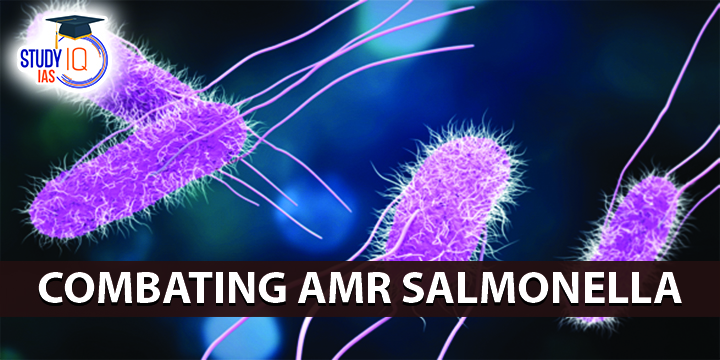Table of Contents
What Is Anti Microbial Resistance (AMR)
Anti Microbial Resistance Salmonella is a condition in which bacteria, viruses, fungi and parasites change over time and no longer respond to medicines.
Causes: AMR occurs naturally over time, usually through genetic changes. These genetic changes are accelerated through over-exposure to anti-biotic drugs.
Other reasons for Anti Microbial Resistance include poor access to quality, affordable medicines, vaccines and diagnostics.
Impact: AMR reduce efficacy of drugs, increasing the risk of disease spread, severe illness and death.
Anti Microbial Resistance also increases the cost of research in developing new drugs to treat infections caused by mutant pathogens.

Anti Microbial Resistance Salmonella Background
- The widespread use of traditional antibiotics gives rise to the emergence of drug resistant phenotype in typhoidal and non-typhoidal Salmonella serovars.
- This anti-microbial resistance has increased the difficulties in curing Salmonella-induced food-borne illnesses (majorly typhoid or paratyphoid fever, gastroenteritis, and diarrhoea) worldwide.
- Instances of drug-resistance: Recent studies have shown the emergence of Multi-drug Resistant (MDR) phenotype in Salmonella tphimurium DT104. It causes infection in humans and cattle.
- Emergence of extensively drug-resistant (XDR) pathogen in Africa posed a significant threat to global health.
- MDR mechanism in salmonella pathogen:
- The MDR phenotype in salmonella pathogen was provided by Salmonella Genomic Island-1 (SGI-1).
- It provides protection against antibiotics such as ampicillin (pse-1), chloramphenicol/florfenicol (floR), streptomycin/spectinomycin (aadA2), sulphonamides (sul1), and tetracycline (tetG) (ACSSuT).
Salmonella:
- Salmonella is a gram-negative bacterial genus belonging to the Enterobacteriaceae family that affects intestinal tract. Infection most frequently occurs through contaminated water or food.
- Most commons symptoms of salmonella infection are diarrhea, fever and stomach (abdominal) cramps, nausea, vomiting, chills etc.
Anti Microbial Resistance Salmonella Research
- The study showed that deleting outer membrane protein A (OmpA) from Salmonella hampered its survival in the presence of two β-lactam drugs (ceftazidime and meropenem).
- OmpA is one of the most abundant barrel-shaped porin proteins located in the outer membrane of Salmonella.
- Importance of outer member protein:
- Gram-negative pathogens use outer membrane porin protein for purposes, ranging from maintaining outer membrane stability to developing antimicrobial resistance (AMR).
Anti Microbial Resistance Salmonella Bacteria
- Gram-positive: Gram-positive bacteria are a category of bacteria that have a thick cell wall. This cell wall protects the bacteria from environment.
- Gram-positive bacteria do not have an outer membrane. They appear blue or purple during stain test.
- Despite thicker cell wall, they are vulnerable to certain types of anti-biotic that target cell wall.
- Gram-negative: Gram negative bacteria do not have thick cell walls. However, they have outer lipid membrane that protects them from their environment.
- They are more resistant to antibiotics and are increasingly difficult to treat. They appear pink or red in the stain test.
- They have the ability to pass along genetic materials that allow other bacteria to become drug-resistant.
- Role of OmpA in reducing AMR:
-
- The Outer Membrane Protein A (OmpA) could restrict the entry of antibiotics into the bacteria. This improves the survival of the pathogen under antibiotic treatment.
- The absence of OmpA in Salmonella hampers the stability of the bacterial outer membrane and reduces the expression of certain genes.
- Removing OmpA resulted in a greater intake of ceftazidime and meropenem drugs, which ultimately killed the mutant bacteria by disrupting its outer envelope.
- Weak outer membrane in the absence of OmpA makes the bacteria highly susceptible to killing by the host’s innate immune system.
-
- Significance of Research:
- The continuous adaptation of salmonella to the available antibiotics creates a risk of developing antimicrobial resistance in the future.
- It is necessary to study the effect of new drugs and find their potential targets to be effective against the pathogen.
- Developing anti-microbial drugs that target outer membrane protein (OmpA) can effectively reduce the risk of antimicrobial resistance (AMR) in the future.


 Serious Fraud Investigation Office (SFIO...
Serious Fraud Investigation Office (SFIO...
 Article 142 of Indian Constitution, Sign...
Article 142 of Indian Constitution, Sign...
 Pakistan-Occupied Kashmir (PoK): History...
Pakistan-Occupied Kashmir (PoK): History...





















